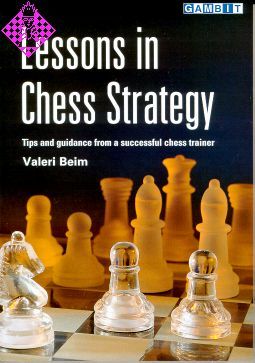Artikelnummer
LMBEILICS
Autor
Lessons in Chess Strategy
176 Seiten, kartoniert, Gambit, 1. Auflage 2003
Final vergriffen
Following on from his successful book Chess Recipes from the Grandmaster's Kitchen, Valeri Beim serves up a further series of lessons on important general chess topics.
His expert advice will help you to handle a whole range of typical situations with greater confidence and understanding. Topics include:
Geometry of the chessboard
Isolated centre pawn
Central passed pawn
Space advantage
Zugzwang
Bishop-pair
Symmetrical pawn-structures
Static and dynamic features
Beim focuses on both typical methods of play and thinking procedures, such as using the concept of 'resulting moves' to help find zugzwang possibilities. The book contains a wealth of examples of how the greatest players in chess history have addressed these vital themes in practice.
There are a total of 124 exercises to test the reader's understanding. Full and detailed solutions are given.
'The time has come', the Walrus said,
'To talk of many things:
Of shoes - and ships - and sealing wax:
Of cabbages and kings'
LEWIS CARROLL, Through the Looking Glass
This is a book for all chess enthusiasts. It is for those who are firmly aware that they will never become a professional player, but like playing chess and wish to beat that unpleasant chap from the nearby club who has already beaten you three times in the same infuriating way. It is also for those who have only recently started playing chess and would perhaps like to make it their main pastime.
Even if this is not the case, it is also a book for those who wish to keep chess in their lives as a wonderful pastime. A game which is intriguing, enjoyable, and able to provide us with something which is both unique and which does not often occur in everyday life - the pleasure of creativity.
I also hope that not only amateur players, but also chess professionals can find something of interest and instructional value in this book. However, even if this book raises cause for criticism alone -I would like to give thanks for that as well! In my opinion, the most important thing is to interest the reader and perhaps to alter to some extent his existing opinions or habits, something which is always a sign of progress. It is also the aim of this book to capture the imagination of those who have not yet established any specific ideas and possibly to help them find their own outlook on the game of chess.
To some extent, this venture was visualized as a continuation of my first book Chess Recipes from the Grandmaster's Kitchen, with which I hope the reader is also familiar. This book centred mainly on methods of thinking in chess. Specifically, I aimed to show how the various problems that occur during a game of chess should be approached when searching for a
solution. However, in the present book we will for the most part discuss more customary themes that occur during a game. In other words, what you must know, and what you must be able to do, in order to play successfully.
I feel that this is the correct order in which to instruct the reader. Firstly we have shown how to cope with the variety of problems that occur during a game, and only then do we acquaint the reader with the potential diversity of these subjects.
This book will examine the various principles relating to the game of chess. For example, we will look at how to deal with the typical ways of playing positions by looking at various pawn-structures and positions with a fixed material balance as well as other subjects that make up the very heart of chess strategy. However, we will not just be dealing with the aforementioned subject matter. The most important part of the book is Chapter 9, 'Static and Dynamic Features', although we will be concentrating mainly on the former. I would also like to draw specific attention to a unique chapter, albeit with a familiar-sounding title - Chapter 6, 'Zugzwang'. This is a chapter in which I have adopted a somewhat different approach to the subject in question.
Of course, it is neither possible nor necessary to exhaust the entire range of situations that might occur in every circumstance. It makes sense to select and examine only the most critical and characteristic examples. Thus, I feel it is important and interesting to show not only the most technical, tactical, and strategically complex positions and the various ways they can be solved, but also to illustrate the opinions of great chess minds on precisely these subjects.
I have therefore aimed to use games played by the very strongest players throughout the book. This is based on the belief that, if you wish to learn to do something well, the best thing of all is to see how a real expert does it.
It is true that strong players never play 'off the cuff', without having given the position some thought. The very thing that characterizes outstanding players is the ability to think deeply and independently. It is this very skill that separates such players from the rest. Each move made by a strong master will make sense, even if it works out unsuccessfully on occasions. The situation often occurs where a decision taken from certain specific features of the position may turn out badly, but the thought behind it is profound and important all the same. Finally, this incorrect move, or even entire plan, is unfortunate only for the player concerned; the rest of us on the other hand can surely benefit from studying the game in question.
Without doubt, the games of great masters not only push forward the development of chess itself, but also help it break free from old-fashioned principles, and alter established, and often incorrect, attitudes.
It is because of this that discussions so frequently explain how the very roots of chess have changed, and that the games of past masters, even the very strongest, are no longer needed nowadays - but this is utter nonsense!
Take the games of the old masters; let's say, for example, the match between Labourdonnais and McDonnell. Here you will see what we would nowadays consider to be naive and outlandish decisions side by side with amazing bursts of fantasy, brilliant calculation and magnificent intuition. What, therefore, can be said of the games of Morphy, Steinitz, and Capablanca! I, for instance, have always been struck by how Paul Morphy's approach to chess was so remarkably ahead of its time.
The archaic opening variations seen in these games have rarely passed the test of time, but the fundamental principles through which they were played are still relevant...
Furthermore, is not true that the chess-player of today can learn something from this?
This raises another issue - from what sources is it best to study the games of the great masters?
Firstly, it is essential that you study annotated games.
The problem is that for the average player it is very difficult, and indeed nearly impossible, to analyse a game on one's own. (Analysis engines are not always of great use for this task; they are best in positions where play is forced, but even then you need to know how to interpret the results, which is difficult for the average chess enthusiast.) It is important to learn how to analyse by yourself from the very beginning. It is possible to do this by looking at how the real professionals do it.
Secondly, the games you study must be annotated well !
For this you must be aware that, for the average chess enthusiast (for whom this book is first and foremost intended), particular value is attributed not so much to annotated variations (although these are of course important; they must be accurate and their location in the game itself must also be justified) as to verbally explanations of why a specific move was made. When a game is annotated well, observations such as these are of enormous benefit...
By finding and studying examples that illustrate the aforementioned general principles of chess, it is entirely possible for the rank-and-file player to make a significant leap in his own playing ability! (Incidentally, White won the above game.)
So there is always something that we can learn from great players; first and foremost is the ability to think independently, based on a foundation of the deepest and most extensive knowledge. This is the most difficult thing to achieve in chess, but also the most important.
In the computer era of chess today an entire generation of players has emerged who place great emphasis on studying opening variations using computerized tools in order to gain a theoretical advantage. However, while opening
knowledge is of course important, it will not decide the outcome of the game. Suppose I emerge from the opening with a better, or even vastly superior position, the time will come to work out how to continue play after this. If I have no understanding of the position, I will find it difficult to work it out on my own. Moreover, how is it possible to tackle a new position with which you are unfamiliar? In this instance, even the most advantageous position can be ruined in only a few moves.
I have no doubt that the most important thing in chess is the ability to think for yourself. Similarly, the most important thing in a player's education is the ability to teach himself. I believe that solving exercises plays an important part in this process. Time spent solving exercises not only helps develop our ability to solve the most diverse problems independently, but also helps us to examine for ourselves the very process of learning. As if we were able to hold it in front of our eyes and turn it to see it from different sides, so we can increase the sum of our knowledge in different subjects. By completing these tasks the reader will obtain additional knowledge in all of the subjects covered in this book while also training himself in making independent decisions in a variety of different positions, which is what the game of chess essentially is.
I would very much like to attach (not only to this book, but also to my previous one, and God permitting, any that I may write in the future) the following words, written by Garry Kasparov about Shakhmatnye Lektsii (Petrosian):
"This book is neither a textbook nor a guide in the traditional sense... It instead fills another, more important function, namely teaching the reader how to think, or more specifically, how it is necessary to think, since thinking for oneself in chess does not always work out successfully."
Valeri Beim Vienna, Austria
His expert advice will help you to handle a whole range of typical situations with greater confidence and understanding. Topics include:
Geometry of the chessboard
Isolated centre pawn
Central passed pawn
Space advantage
Zugzwang
Bishop-pair
Symmetrical pawn-structures
Static and dynamic features
Beim focuses on both typical methods of play and thinking procedures, such as using the concept of 'resulting moves' to help find zugzwang possibilities. The book contains a wealth of examples of how the greatest players in chess history have addressed these vital themes in practice.
There are a total of 124 exercises to test the reader's understanding. Full and detailed solutions are given.
'The time has come', the Walrus said,
'To talk of many things:
Of shoes - and ships - and sealing wax:
Of cabbages and kings'
LEWIS CARROLL, Through the Looking Glass
This is a book for all chess enthusiasts. It is for those who are firmly aware that they will never become a professional player, but like playing chess and wish to beat that unpleasant chap from the nearby club who has already beaten you three times in the same infuriating way. It is also for those who have only recently started playing chess and would perhaps like to make it their main pastime.
Even if this is not the case, it is also a book for those who wish to keep chess in their lives as a wonderful pastime. A game which is intriguing, enjoyable, and able to provide us with something which is both unique and which does not often occur in everyday life - the pleasure of creativity.
I also hope that not only amateur players, but also chess professionals can find something of interest and instructional value in this book. However, even if this book raises cause for criticism alone -I would like to give thanks for that as well! In my opinion, the most important thing is to interest the reader and perhaps to alter to some extent his existing opinions or habits, something which is always a sign of progress. It is also the aim of this book to capture the imagination of those who have not yet established any specific ideas and possibly to help them find their own outlook on the game of chess.
To some extent, this venture was visualized as a continuation of my first book Chess Recipes from the Grandmaster's Kitchen, with which I hope the reader is also familiar. This book centred mainly on methods of thinking in chess. Specifically, I aimed to show how the various problems that occur during a game of chess should be approached when searching for a
solution. However, in the present book we will for the most part discuss more customary themes that occur during a game. In other words, what you must know, and what you must be able to do, in order to play successfully.
I feel that this is the correct order in which to instruct the reader. Firstly we have shown how to cope with the variety of problems that occur during a game, and only then do we acquaint the reader with the potential diversity of these subjects.
This book will examine the various principles relating to the game of chess. For example, we will look at how to deal with the typical ways of playing positions by looking at various pawn-structures and positions with a fixed material balance as well as other subjects that make up the very heart of chess strategy. However, we will not just be dealing with the aforementioned subject matter. The most important part of the book is Chapter 9, 'Static and Dynamic Features', although we will be concentrating mainly on the former. I would also like to draw specific attention to a unique chapter, albeit with a familiar-sounding title - Chapter 6, 'Zugzwang'. This is a chapter in which I have adopted a somewhat different approach to the subject in question.
Of course, it is neither possible nor necessary to exhaust the entire range of situations that might occur in every circumstance. It makes sense to select and examine only the most critical and characteristic examples. Thus, I feel it is important and interesting to show not only the most technical, tactical, and strategically complex positions and the various ways they can be solved, but also to illustrate the opinions of great chess minds on precisely these subjects.
I have therefore aimed to use games played by the very strongest players throughout the book. This is based on the belief that, if you wish to learn to do something well, the best thing of all is to see how a real expert does it.
It is true that strong players never play 'off the cuff', without having given the position some thought. The very thing that characterizes outstanding players is the ability to think deeply and independently. It is this very skill that separates such players from the rest. Each move made by a strong master will make sense, even if it works out unsuccessfully on occasions. The situation often occurs where a decision taken from certain specific features of the position may turn out badly, but the thought behind it is profound and important all the same. Finally, this incorrect move, or even entire plan, is unfortunate only for the player concerned; the rest of us on the other hand can surely benefit from studying the game in question.
Without doubt, the games of great masters not only push forward the development of chess itself, but also help it break free from old-fashioned principles, and alter established, and often incorrect, attitudes.
It is because of this that discussions so frequently explain how the very roots of chess have changed, and that the games of past masters, even the very strongest, are no longer needed nowadays - but this is utter nonsense!
Take the games of the old masters; let's say, for example, the match between Labourdonnais and McDonnell. Here you will see what we would nowadays consider to be naive and outlandish decisions side by side with amazing bursts of fantasy, brilliant calculation and magnificent intuition. What, therefore, can be said of the games of Morphy, Steinitz, and Capablanca! I, for instance, have always been struck by how Paul Morphy's approach to chess was so remarkably ahead of its time.
The archaic opening variations seen in these games have rarely passed the test of time, but the fundamental principles through which they were played are still relevant...
Furthermore, is not true that the chess-player of today can learn something from this?
This raises another issue - from what sources is it best to study the games of the great masters?
Firstly, it is essential that you study annotated games.
The problem is that for the average player it is very difficult, and indeed nearly impossible, to analyse a game on one's own. (Analysis engines are not always of great use for this task; they are best in positions where play is forced, but even then you need to know how to interpret the results, which is difficult for the average chess enthusiast.) It is important to learn how to analyse by yourself from the very beginning. It is possible to do this by looking at how the real professionals do it.
Secondly, the games you study must be annotated well !
For this you must be aware that, for the average chess enthusiast (for whom this book is first and foremost intended), particular value is attributed not so much to annotated variations (although these are of course important; they must be accurate and their location in the game itself must also be justified) as to verbally explanations of why a specific move was made. When a game is annotated well, observations such as these are of enormous benefit...
By finding and studying examples that illustrate the aforementioned general principles of chess, it is entirely possible for the rank-and-file player to make a significant leap in his own playing ability! (Incidentally, White won the above game.)
So there is always something that we can learn from great players; first and foremost is the ability to think independently, based on a foundation of the deepest and most extensive knowledge. This is the most difficult thing to achieve in chess, but also the most important.
In the computer era of chess today an entire generation of players has emerged who place great emphasis on studying opening variations using computerized tools in order to gain a theoretical advantage. However, while opening
knowledge is of course important, it will not decide the outcome of the game. Suppose I emerge from the opening with a better, or even vastly superior position, the time will come to work out how to continue play after this. If I have no understanding of the position, I will find it difficult to work it out on my own. Moreover, how is it possible to tackle a new position with which you are unfamiliar? In this instance, even the most advantageous position can be ruined in only a few moves.
I have no doubt that the most important thing in chess is the ability to think for yourself. Similarly, the most important thing in a player's education is the ability to teach himself. I believe that solving exercises plays an important part in this process. Time spent solving exercises not only helps develop our ability to solve the most diverse problems independently, but also helps us to examine for ourselves the very process of learning. As if we were able to hold it in front of our eyes and turn it to see it from different sides, so we can increase the sum of our knowledge in different subjects. By completing these tasks the reader will obtain additional knowledge in all of the subjects covered in this book while also training himself in making independent decisions in a variety of different positions, which is what the game of chess essentially is.
I would very much like to attach (not only to this book, but also to my previous one, and God permitting, any that I may write in the future) the following words, written by Garry Kasparov about Shakhmatnye Lektsii (Petrosian):
"This book is neither a textbook nor a guide in the traditional sense... It instead fills another, more important function, namely teaching the reader how to think, or more specifically, how it is necessary to think, since thinking for oneself in chess does not always work out successfully."
Valeri Beim Vienna, Austria
| EAN | 9781901983937 |
|---|---|
| Gewicht | 340 g |
| Hersteller | Gambit |
| Breite | 17,2 cm |
| Höhe | 24,5 cm |
| Medium | Buch |
| Erscheinungsjahr | 2003 |
| Autor | Valeri Beim |
| Sprache | Englisch |
| Auflage | 1 |
| ISBN-10 | 1901983935 |
| ISBN-13 | 9781901983937 |
| Seiten | 176 |
| Einband | kartoniert |
| Name | Gambit Publications Ltd. |
|---|---|
| Adresse | 27 Queens Pine, Bracknell Berkshire RG12 OTL Großbritannien |
| Internet | www.gambitbooks.com |
| info@gambitbooks.com |
Verantwortlicher Importeuer:
| Name | Schachversand Niggemann |
|---|---|
| Adresse | Schadowstraße 5 48163 Münster Deutschland |
| info@schachversand.de | |
| Internet | www.schachversand.de |
004 Symbols
005 Introduction
008 1 The Geometry of the Chessboard
020 2 The Major Pieces
032 3 The Isolated Centre Pawn
044 4 The Central Passed Pawn
055 5 The Space Advantage
068 6 Zugzwang
080 7 The Bishop-Pair
093 8 Symmetrical Pawn-Structures
104 9 Static and Dynamic Features
130 Solutions to Exercises
173 Index of Games
176 Index of Composers and Analysts
176 Index of Openings
005 Introduction
008 1 The Geometry of the Chessboard
020 2 The Major Pieces
032 3 The Isolated Centre Pawn
044 4 The Central Passed Pawn
055 5 The Space Advantage
068 6 Zugzwang
080 7 The Bishop-Pair
093 8 Symmetrical Pawn-Structures
104 9 Static and Dynamic Features
130 Solutions to Exercises
173 Index of Games
176 Index of Composers and Analysts
176 Index of Openings
This is a follow up to Beim's first book, Chess Recipes_from the Grandmaster's Kitchen. But whereas that book dealt with the thinking process in chess, this present volume concentrates more on basics, on the knowledge that must necessarily be acquired for success at the board.
There are nine chapters, whose titles are more or less self-explanatory - The Geometry of the Chessboard, The Major Pieces, The Isolated Centre Pawn, The Central Passed Pawn, The Space Advantage, Zugzwang, The Bishop Pair, Symmetrical Pawnstructures, Static and Dynamic Features. Each chapter contains several examples of the theme under discussion, an eclectic mixture of old and more recent games. But more importantly, this is an interactive book, so each chapter has a number of exercises attached, 124 in total. I have to admit that 1 found most of these exercises rather difficult, but this is preferable to positions which are so simple that they can be solved at a glance.
My reaction to Chess Recipes was lukewarm, because I felt that the author failed to communicate clearly with the reader (or with this reader at least). However, in this second book, his aims are much more clearly stated, and the material presented in a more orderly and logical manner. It is certainly not a primer for raw beginners, but there is a lot in it that will benefit club players of all abilities, especially the exercises which are well chosen and stretch the imagination.
Alan Sutton, "En Passant"
There are nine chapters, whose titles are more or less self-explanatory - The Geometry of the Chessboard, The Major Pieces, The Isolated Centre Pawn, The Central Passed Pawn, The Space Advantage, Zugzwang, The Bishop Pair, Symmetrical Pawnstructures, Static and Dynamic Features. Each chapter contains several examples of the theme under discussion, an eclectic mixture of old and more recent games. But more importantly, this is an interactive book, so each chapter has a number of exercises attached, 124 in total. I have to admit that 1 found most of these exercises rather difficult, but this is preferable to positions which are so simple that they can be solved at a glance.
My reaction to Chess Recipes was lukewarm, because I felt that the author failed to communicate clearly with the reader (or with this reader at least). However, in this second book, his aims are much more clearly stated, and the material presented in a more orderly and logical manner. It is certainly not a primer for raw beginners, but there is a lot in it that will benefit club players of all abilities, especially the exercises which are well chosen and stretch the imagination.
Alan Sutton, "En Passant"
GM Valeri Beim stammt aus der Ukraine, lebt in Wien und spielt in der österreichischen und deutschen Bundesliga. Früher fungierte er viele Jahre als Cheftrainer der Schachschule Odessa und des israelischen Olympia-Teams. Sein drittes englischsprachiges Schachbuch (nach den Vorgängern „Schachrezepte aus der Großmeisterküche" und „Verstehen der Leningrader Variante in Holländisch" ) erteilt „Lektionen in Schach-Strategie" und wendet sich in erster Linie an den ambitionierten Vereinsspieler. Beim zeigt anhand vieler Beispiele - insgesamt 35 vollständige Partien, 50 Partiefragmente bzw. Endspielstudien, sowie 124 Übungsaufgaben für den Leser, allesamt entnommen aus der Praxis erstklassiger Meister und jeweils den einzelnen Kapiteln folgend (mit Ausnahme des letzten) - die Prinzipien des Kampfes am Brett auf und will den Leser zum unabhängigen, selbstständigen Denken anleiten (Vorwort S. 7). Die einzelnen Kapitel befassen sich mit folgenden Themen: 1) „Die Geometrie des Schachbrettes" (S. 8-19) behandelt verschiedene geometrische Motive, speziell in Turm-und Bauernendspielen; 2 ) „Die Schwerfiguren" (S. 20-31) werden in ihrer Zusammenarbeit untereinander und in Verbindung mit den Leichtfiguren vorgestellt;
3) „Der isolierte Zentrumsbauer" (vor allem der d-Isolani) (S. 32-43) zeigt seine Stärken im Mittelspiel und seine Schwächen im Endspiel;
4) „Der Zentrums-Freibauer" (S. 44-54) vermag die gegnerischen Kräfte entscheidend zu binden;
b) „Raumvorteil" (S. 55-67) bedingt eine größere Manövrierfähigkeit der eigenen und Platzmangel der gegnerischen Figuren;
6) „Zugzwang" (S. 68-79): hier erklärt der Autor u.a. eine Methode, einen zugzwang-generierenden Zug zu finden, den „resulting move";
7) „Das Läuferpaar" (S. 80-92) zeigt in der Mehrzahl praktischer Fälle seine Überlegenheit gegenüber anderen Leichtfigur-Konstellationen;
8) „Symmetrische Bauernstrukturen" (S. 93-103), vor allem bei offenem Zentrum, begünstigen das lebhafte Figurenspiel;
9) „Statische und dynamische Merkmale" (S. 104-129): das Schlusskapitel beschäftigt sich vor allem mit den überdauernden = statischen Stellungscharakteristika und mit der Verwertung von Vorteilen auf diesem Gebiet, z.B. Positionsvorteile, bessere Bauernstruktur, Königs-Sicherheit, Läuferpaar, Vorposten u.a.m.
Im Anhang (S. 130-172) werden die ausführlichen Lösungsbesprechungen der 124 Übungsaufgaben dargeboten. Beim führt in exemplarischer Weise typische Spiel- und Denkmethoden des strategischen Schachs vor, wobei seine sorgfältig ausgewählten Beispiele der Turnierpraxis großer Meister aus Vergangenheit und Gegenwart entnommen sind, u.a. von Lasker, Rubinstein, Petrosjan und Anand. Von diesen Vorbildern kann wahrlich jeder Schach-Enthusiast viel lernen (vor allem dann, wenn er ausreichende Englisch-Kenntnisse besitzt)!
Dr. W. Schweizer, Rochade Europa 01/2004
3) „Der isolierte Zentrumsbauer" (vor allem der d-Isolani) (S. 32-43) zeigt seine Stärken im Mittelspiel und seine Schwächen im Endspiel;
4) „Der Zentrums-Freibauer" (S. 44-54) vermag die gegnerischen Kräfte entscheidend zu binden;
b) „Raumvorteil" (S. 55-67) bedingt eine größere Manövrierfähigkeit der eigenen und Platzmangel der gegnerischen Figuren;
6) „Zugzwang" (S. 68-79): hier erklärt der Autor u.a. eine Methode, einen zugzwang-generierenden Zug zu finden, den „resulting move";
7) „Das Läuferpaar" (S. 80-92) zeigt in der Mehrzahl praktischer Fälle seine Überlegenheit gegenüber anderen Leichtfigur-Konstellationen;
8) „Symmetrische Bauernstrukturen" (S. 93-103), vor allem bei offenem Zentrum, begünstigen das lebhafte Figurenspiel;
9) „Statische und dynamische Merkmale" (S. 104-129): das Schlusskapitel beschäftigt sich vor allem mit den überdauernden = statischen Stellungscharakteristika und mit der Verwertung von Vorteilen auf diesem Gebiet, z.B. Positionsvorteile, bessere Bauernstruktur, Königs-Sicherheit, Läuferpaar, Vorposten u.a.m.
Im Anhang (S. 130-172) werden die ausführlichen Lösungsbesprechungen der 124 Übungsaufgaben dargeboten. Beim führt in exemplarischer Weise typische Spiel- und Denkmethoden des strategischen Schachs vor, wobei seine sorgfältig ausgewählten Beispiele der Turnierpraxis großer Meister aus Vergangenheit und Gegenwart entnommen sind, u.a. von Lasker, Rubinstein, Petrosjan und Anand. Von diesen Vorbildern kann wahrlich jeder Schach-Enthusiast viel lernen (vor allem dann, wenn er ausreichende Englisch-Kenntnisse besitzt)!
Dr. W. Schweizer, Rochade Europa 01/2004
Mehr von Gambit
-
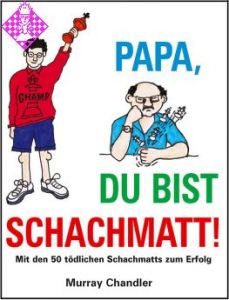 Papa, Du bist Schachmatt!16,50 €
Papa, Du bist Schachmatt!16,50 € -
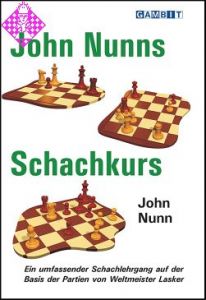 John Nunns Schachkurs17,95 €
John Nunns Schachkurs17,95 € -
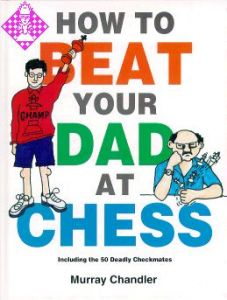 How to beat your dad at chess14,95 €
How to beat your dad at chess14,95 € -
 Chess Openings for Kids15,50 €
Chess Openings for Kids15,50 € -
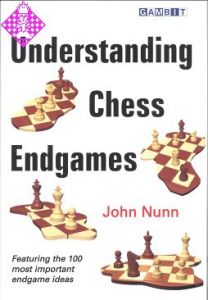 Understanding Chess Endgames24,50 €
Understanding Chess Endgames24,50 € -
 Chess Endgame Workbook for Kids17,50 €
Chess Endgame Workbook for Kids17,50 € - Mehr von Gambit

